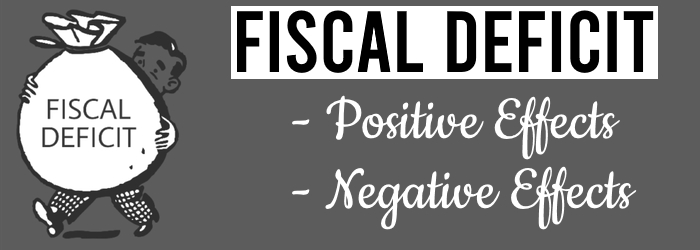Fiscal Deficit | Positive and Negative Impacts on Economic Growth
A fiscal deficit is the difference between a government’s total revenue and its total expenditure in a given fiscal year. It is calculated by subtracting the government’s total revenue from its total expenditure. While fiscal deficits can have positive impacts on economic growth, such as stimulating the economy through increased government expenditure on public services and infrastructure, creating jobs and increasing consumer demand, they can also have negative consequences if not managed properly.
In this article, we will discuss both the positive and negative impacts of fiscal deficits on economic growth and explore how deficit spending can both facilitate and hinder long-term economic development. Understanding these trade-offs is essential for policymakers to ensure sustainable economic growth and avoid the potentially damaging consequences of excessive deficits.

Table of Contents
Positive impacts of Fiscal Deficit on Economic Growth
1. Stimulating Economic Activity
One of the primary ways in which fiscal deficits can positively impact economic growth is by stimulating economic activity. When the government spends money on infrastructure projects, it creates jobs and generates income for workers, who in turn spend their wages on goods and services. This increased spending can then stimulate further economic activity and create a multiplier effect.
For example, suppose the government invests in a new highway project, creating jobs for construction workers and engineers. These workers then spend their earnings on housing, food, transportation, and other goods and services, which in turn generate revenue for businesses. As a result, the overall economy experiences increased activity, leading to growth and development.
2. Increased Investment
Fiscal deficits can also lead to increased investment, both from the private sector and the government itself. When the government spends money on infrastructure projects, it can create opportunities for private investment in related industries. For example, if the government invests in renewable energy, private companies may also invest in related technologies or infrastructure.
Moreover, government spending can stimulate investment in areas that may not have been attractive to investors before. For example, if a government invests in a new high-speed rail system, it can create opportunities for real estate development along the rail line, leading to increased investment in the surrounding areas.
3. Social Welfare Programs
Fiscal deficits can also support social welfare programs that can lead to long-term economic growth. By providing access to education, healthcare, and other basic needs, these programs can improve the overall health and well-being of the population. This can lead to a more productive workforce, which can contribute to long-term economic growth.
For example, suppose a government invests in universal healthcare. In that case, it can lead to a healthier population that is more productive and less likely to miss work due to illness. Additionally, access to healthcare can prevent illnesses from becoming chronic, which can reduce long-term healthcare costs and improve productivity.
4. Countercyclical Policy
Another positive impact of fiscal deficits is their ability to act as countercyclical policy. During periods of economic downturn, governments can increase spending to support economic activity, even if it means running a deficit. This can help stabilize the economy and prevent a recession from becoming a depression.
For example, during the 2008 financial crisis, many governments around the world implemented fiscal stimulus packages to support their economies. This included increased spending on infrastructure, social welfare programs, and tax cuts. These measures helped to stabilize the global economy and prevent a severe recession from becoming a depression.
5. Long-Term Investment
Finally, fiscal deficits can support long-term investment in infrastructure and other critical areas of the economy. Many infrastructure projects, such as highways, bridges, and ports, have long useful lives and can generate economic benefits for decades. By investing in these projects today, governments can create a foundation for long-term economic growth and development.
Moreover, by investing in critical areas such as healthcare, education, and research and development, governments can support innovation and technological progress, which can drive economic growth in the long run.
Negative impacts of Fiscal Deficit on Economic Growth
1. Inflation
One of the most significant negative impacts of fiscal deficits is inflation. When a government spends more money than it earns, it must borrow to finance the deficit. This increases the supply of money in the economy, which can lead to inflation as demand for goods and services outstrips supply.
For example, if the government spends money on infrastructure projects, it creates jobs and generates income for workers, who in turn spend their wages on goods and services. This increased spending can then lead to higher prices for those goods and services, leading to inflation.
2. Higher Interest Rates
Fiscal deficits can also lead to higher interest rates. When a government borrows to finance a deficit, it must pay interest on the borrowed funds. This increases the demand for credit in the economy, which can drive up interest rates.
Higher interest rates can discourage investment and borrowing, leading to lower economic growth. Moreover, high interest rates can make it more difficult for governments to finance future deficits, as the cost of borrowing increases.
3. Reduced Investor Confidence
Fiscal deficits can also reduce investor confidence in the economy. When investors see that a government is running a deficit, they may become concerned about the government’s ability to repay its debt. This can lead to a reduction in demand for government bonds and other investments, driving up interest rates and making it more difficult for the government to finance future deficits.
Reduced investor confidence can also lead to a reduction in foreign investment, which can have negative impacts on economic growth. Foreign investors may view a government with a large fiscal deficit as a risky investment, leading them to look elsewhere for investment opportunities.
4. Crowding Out Effect
Fiscal deficits can also lead to a crowding out effect, where government borrowing reduces the availability of credit for private investment. When a government borrows to finance a deficit, it competes with private borrowers for credit in the economy. This can lead to higher interest rates and reduced access to credit for private borrowers, leading to lower levels of private investment.
Lower levels of private investment can lead to reduced economic growth, as businesses may be less able to invest in new projects or expand their operations.
5. Unsustainable Debt
Finally, one of the most significant negative impacts of fiscal deficits is unsustainable debt. When a government runs a deficit year after year, it can accumulate a significant amount of debt. This debt can become unsustainable if it reaches levels that the government cannot realistically repay.
Unsustainable debt can lead to a fiscal crisis, where the government is unable to borrow money to finance its deficit or repay its existing debt. This can lead to economic instability, as investors lose confidence in the economy and businesses may struggle to access credit.
Conclusion
Fiscal deficits can have both positive and negative impacts on economic growth. While deficit spending can stimulate economic activity, lead to increased investment, support social welfare programs, act as countercyclical policy, and support long-term investment, it can also lead to inflation, higher interest rates, reduced investor confidence, and the crowding out effect. Therefore, policymakers must carefully manage fiscal deficits to ensure sustainable economic growth and avoid the potential negative consequences of excessive deficits.



